Transport and Communication Class 12 Geography
| Table of contents |

|
| Transport |

|
| Modes of Transportation |

|
| Land Transport |

|
| Water Transport |

|
| Air Transport |

|
| Pipelines |

|
| Communications |

|
Transport
Transport is defined as a service that facilitates the movement of people and goods from one location to another, utilizing humans, animals, and various vehicles.

- This movement occurs across three primary environments: land, water, and air.
- Modes of Land Transport: Roads and railways are essential components of land transportation.
- Water and Air Transport: Shipping and waterways, along with airways, represent the other two transportation modes.
- Additionally, pipelines are used to transport materials such as petroleum, natural gas, and ores in liquid form.
- Transportation functions as an organized service industry designed to meet the fundamental needs of society.
- This system encompasses transport arteries, vehicles for moving people and goods, and the organization responsible for maintaining these routes and managing loading, unloading, and delivery processes.
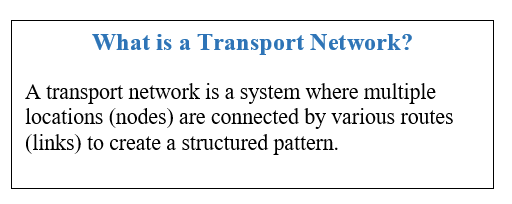
Modes of Transportation
- The main means of transportation on a global scale are land, water, air, and pipelines.
- When it comes to international transport of goods, ocean freighters are the preferred mode of transportation.
- For short distances and door-to-door services, road transport is faster and more affordable. Railways are well-suited for the transportation of large quantities of bulky materials over long distances within a country.
- For high-value, light, and perishable goods, air travel is the most suitable mode of transportation.
Land Transport
- The majority of the movement of goods and services occurs via land transportation.
- The use of carts and wagons became crucial after the invention of the wheel.
- The transportation industry underwent a revolution following the development of the steam engine in the 18th century.
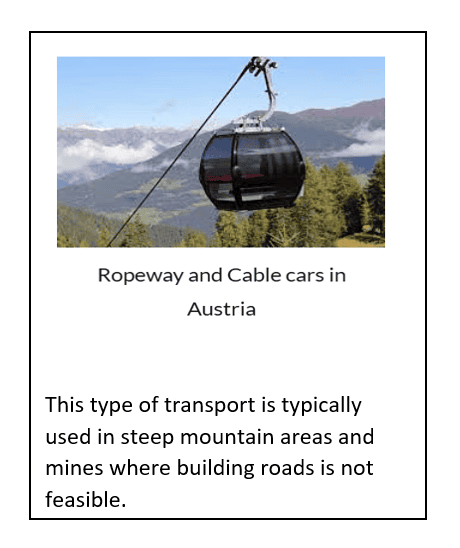
- In 1825, the first public railway line was opened between Stockton and Darlington in northern England, after which railways quickly became the most popular and fastest mode of transportation during the 19th century.
- In addition to traditional land transportation methods, such as railways and roads, newer developments such as pipelines, ropeways, and cableways have emerged.
- Pipelines are used to transport liquids like mineral oil, water, sludge, and sewers.
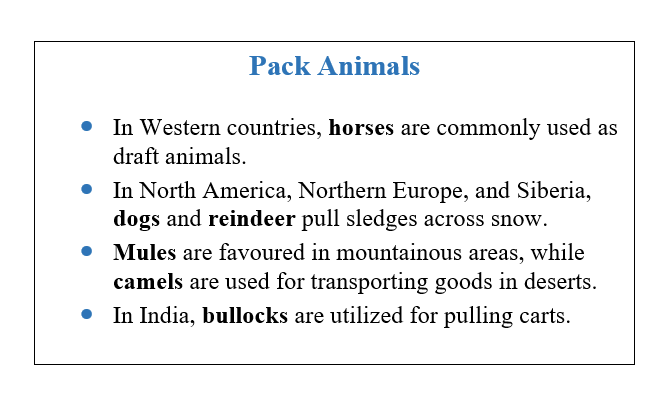
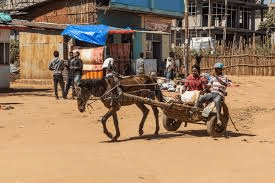 A horse cart in a village Tefki, in Ethiopia
A horse cart in a village Tefki, in Ethiopia
Roads
- Cost-Effectiveness: Road transport is more economical for short distances than railways.
- Freight Importance: Freight transport by road is becoming increasingly important because it provides door-to-door service.
- Road Conditions: Unmetalled roads are easy to build but often unusable in all seasons, especially during the rainy season. Even metalled roads can be severely affected by heavy rains and floods.
- Rail Advantages: Railways, with their high embankments and better maintenance, offer a reliable alternative during adverse weather, but their limited coverage cannot meet the needs of large, developing countries at low costs.
- Economic Role: Roads are crucial for a nation’s trade, commerce, and tourism.
- Quality Disparities: Road quality varies significantly between developed and developing countries, largely due to the high costs of construction and maintenance.
- Developed Countries: In developed nations, high-quality roads are common, featuring long-distance routes like motorways and interstate highways that facilitate fast travel. Larger lorries for heavy loads are also typical.
- Global Road System: The global road network is underdeveloped, totaling about 15 million km, with North America holding 33% of this length and having the highest road density and vehicle registration.
Traffic Flows
- Increasing Traffic: Road traffic has risen sharply in recent years, leading to congestion when the road network cannot handle the volume.
- Urban Congestion: Many cities face chronic traffic congestion, with peak traffic occurring during rush hours before and after work.
Highways
Highways are well-constructed metalled roads designed for smooth vehicular movement, connecting distant places.
Here are the key features and examples:
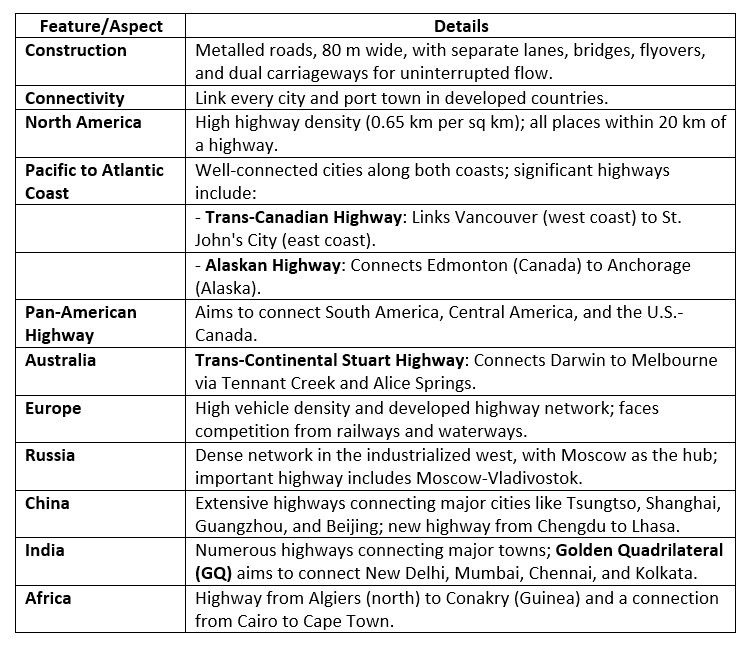
Border Roads
Roads built along international boundaries are known as border roads.
- They help connect remote areas with major cities, fostering integration among people.
- They provide essential defense capabilities.
- Most countries have these roads to facilitate the transportation of goods to border villages and military camps.
Railways
Railways
Railways serve as a mode of land transport for bulky goods and passengers over long distances.
- Rail gauges differ by country and include
1. Broad gauge: More than 1.5 m
2. Standard gauge: 1.44 m (used in the U.K.)
3. Metre gauge: 1 m
4. Smaller gauges: Various smaller sizes - Commuter Trains: Popular in countries like the U.K., U.S.A, Japan, and India, these trains transport millions of passengers daily within cities.
- Global Network: Approximately 1.3 million km of railways are operational worldwide.
- Density in Europe: Europe has one of the densest rail networks, with about 440,000 km of railways, mainly double or multiple-tracked. Belgium has the highest density, with 1 km of railway for every 6.5 sq km.
- Key Rail Hubs: Major rail heads include London, Paris, Brussels, Milan, Berlin, and Warsaw.
- Passenger vs. Freight: Passenger transport is often prioritized over freight in many European countries.
- Underground Systems: Underground railways are significant in cities like London and Paris.
- Channel Tunnel: The Euro Tunnel connects London and Paris.
- Changing Importance: Transcontinental rail lines have diminished in importance due to faster and more flexible air and road transport options.
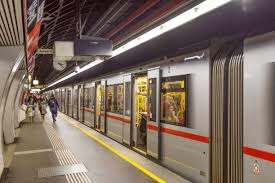 Tube Train in Vienna
Tube Train in Vienna
Railways Around the World:
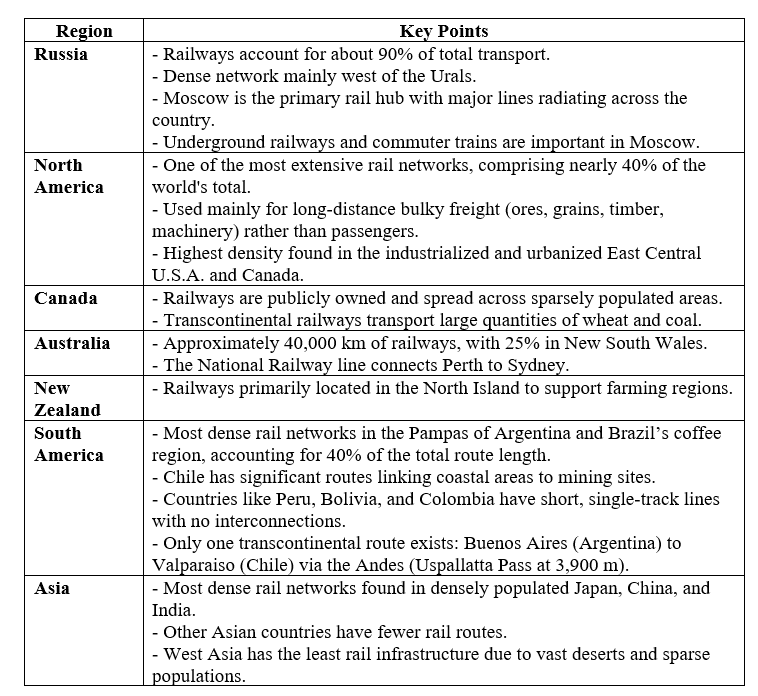
- Africa is the second-largest continent but has only 40,000 km of railways.
- South Africa: Holds 18,000 km of railways due to rich mining activities (gold, diamonds, copper).
- Key Routes:
1. Benguela Railway: Connects Angola to the Katanga-Zambia Copper Belt.
2. Tanzania Railway: Links the Zambian Copper Belt to Dar-es-Salaam on the coast.
3. Railway through Botswana and Zimbabwe: Connects landlocked countries to South Africa's railway network.
4. Blue Train: Travels from Cape Town to Pretoria in South Africa. - Other Countries: In countries like Algeria, Senegal, Nigeria, Kenya, and Ethiopia, railways mainly connect port cities to inland areas but lack strong links with neighboring countries.
Trans–Continental Railways
Trans-continental railways are lines that stretch across a continent, connecting its two ends.
They were built mainly for economic and political purposes, allowing for long-distance travel in various directions. Here are some of the most important ones:
Trans–Siberian Railway
The Trans-Siberian Railway is a major rail route in Russia.
- Route: It stretches from St. Petersburg in the west to Vladivostok on the Pacific coast in the east, passing through key cities like Moscow, Ufa, Novosibirsk, Irkutsk, Chita, and Khabarovsk.
- Significance
1. It is the longest transcontinental railway in the world, measuring 9,332 km.
2. It is fully double-tracked and electrified.
3. This railway has opened up the Asian region to markets in West Europe. - Geographical Features: It crosses important locations like the Ural Mountains and the Ob and Yenisei rivers.
- Chita: An important agricultural center.
- Irkutsk: Known for its fur trade.
- Connections: The railway links to southern destinations including:
1. Odessa (Ukraine)
2. Baku (Caspian Coast)
3. Tashkent (Uzbekistan)
4. Ulan Bator (Mongolia)
5. Shenyang (Mukden) and Beijing (China).
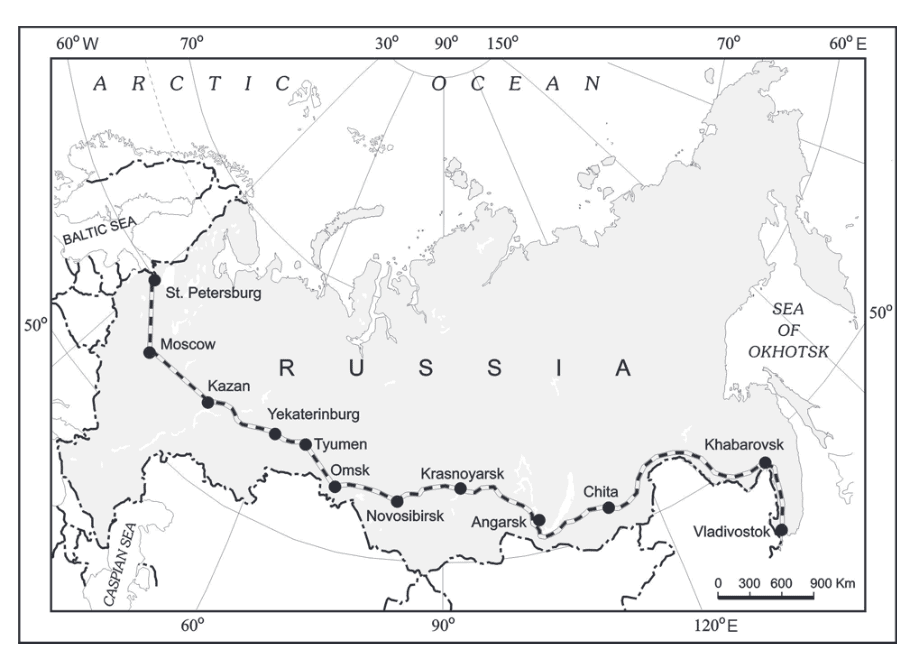 Trans- Siberian Railway
Trans- Siberian Railway
Trans–Canadian Railways
- Length: This railway is 7,050 km long.
- Route: It travels from Halifax in the east to Vancouver on the Pacific Coast, passing through major cities like Montreal, Ottawa, Winnipeg, and Calgary.
- Construction: Built in 1886, it was initially created to help British Columbia join the Federation of States.
- Economic Importance
1. It connects the Quebec-Montreal Industrial Region with the wheat belt of the Prairie Region and the Coniferous Forest in the north.
2. This connection helps the regions work together effectively. - Additional Links: A loop line from Winnipeg to Thunder Bay connects this railway to one of the world's important waterways.
- Significance: This railway is known as the economic artery of Canada. The main exports along this route are wheat and meat.
 Trans–Canadian Railway
Trans–Canadian Railway
The Union and Pacific Railway
- Route: This railway connects New York on the Atlantic Coast to San Francisco on the Pacific Coast.
- Major Cities: It passes through important cities like Cleveland, Chicago, Omaha, Evans, Ogden, and Sacramento.
- Key Exports: The most valuable goods transported on this railway include Ores, Grain, Paper, Chemicals and Machinery.
The Australian Trans–Continental Railway
Major Rail lines in Australia:
- East-West Rail Line: Runs from Perth on the west coast to Sydney on the east coast. Key stops include Kalgoorlie, Broken Hill, and Port Augusta.
- North-South Rail Line: Connects Adelaide to Alice Springs.
This line will connect to the Darwin–Birdum line in the future.
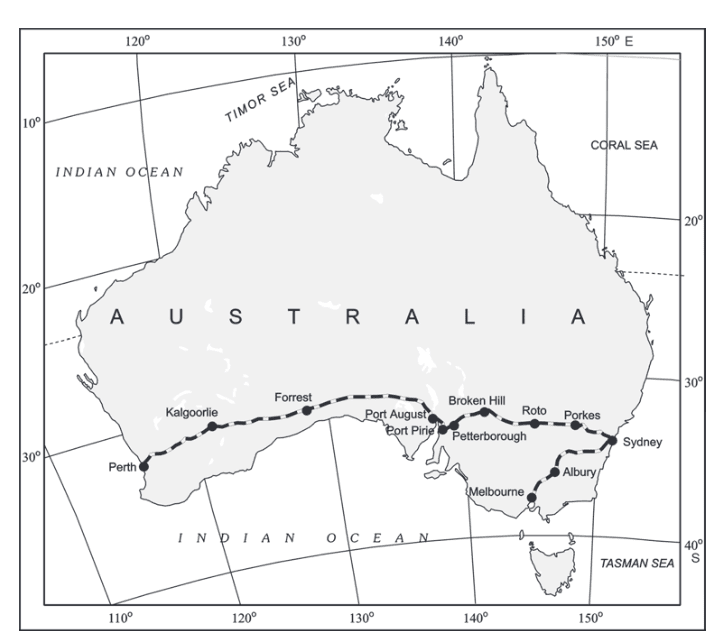 Australian Trans–Continental Railway
Australian Trans–Continental Railway
The Orient Express
- Route: Travels from Paris to Istanbul. Key stops include Strasbourg, Munich, Vienna, Budapest, and Belgrade.
- Travel Time: The trip from London to Istanbul now takes 96 hours by train, compared to 10 days by sea.
- Major Exports: Key goods transported on this route include Cheese, Bacon, Oats, Wine, Fruits and Machinery.
- Future Plans: There is a proposal to build a Trans-Asiatic Railway connecting Istanbul to Bangkok through Iran, Pakistan, India, Bangladesh, and Myanmar.
Water Transport
- No Need for Route Construction: Water transportation doesn't require building specific paths like roads or railways.
- Interconnected Oceans: The oceans are connected, allowing ships of different sizes to travel between them easily.
- Port Facilities Required: The only infrastructure needed is ports at both starting and ending points.
- Cost-Effective: Water transportation is cheaper because there’s less friction in water compared to land.
- Lower Energy Costs: It generally uses less energy, making it more economical.
- Types of Water Transport: Water transport is categorized into sea routes and inland waterways.
Sea Routes
- Smooth Highways: Oceans provide a smooth pathway that can be traveled in any direction without maintenance costs.
- Human Adaptation: Using sea routes is a significant advancement for humans in adapting to their environment.
- Cost-Effective Transport: Ocean transport is cheaper than land or air transport, especially for moving large and heavy materials over long distances between continents.
- Modern Technology: Today's passenger and cargo ships come with advanced tools like radar and wireless communication for navigation.
- Refrigerated Transport: The introduction of refrigerated storage for perishable items, along with tankers and specialized ships, has improved cargo transport.
- Easier Handling: The use of containers has simplified the loading and unloading of goods at major ports worldwide.
Important Sea Routes
1. The Northern Atlantic Sea Route
- Connection: This route connects the North-eastern U.S.A. and North-western Europe, two of the world's most industrialized areas.
- Significant Trade: The foreign trade along this route is larger than the total trade of the rest of the world combined.
- High Volume: One-fourth of the world’s foreign trade occurs on this route, making it the busiest trade route globally.
- Big Trunk Route: It is also known as the "Big Trunk Route" due to its importance in international trade.
- Advanced Ports: Both ends of the route feature highly developed ports and harbor facilities.
2. The Mediterranean–Indian Ocean Sea Route
- Central Location: This sea route runs through the heart of the Old World, connecting many countries and people.
- Major Ports: Important ports along this route include Port Said, Aden, Mumbai, Colombo, and Singapore.
- Suez Canal Impact: The construction of the Suez Canal has significantly shortened the distance and travel time compared to the older route around the Cape of Good Hope, which was much longer.
3. The Cape of Good Hope Sea Route
- Connection: This trade route links the industrialized Western Europe with West Africa, South Africa, Southeast Asia, and the agricultural economies of Australia and New Zealand.
- Increasing Trade: Trade and traffic between East and West Africa are growing due to the development of valuable natural resources.
- Natural Resources: Key resources driving this trade include gold, diamonds, copper, tin, groundnuts, oil palm, coffee, and fruits.
 Major Sea Routes and Sea Ports
Major Sea Routes and Sea Ports
4. The Southern Atlantic Sea Route
- Connection: This sea route links West European and West African countries with Brazil, Argentina, and Uruguay in South America.
- Traffic Levels: The amount of traffic on this route is low due to limited development and population in both South America and Africa.
- Industry Concentration: Large-scale industries are mainly found in southeastern Brazil, the Plata estuary, and parts of South Africa.
- Similar Products: There is minimal traffic between Rio de Janeiro and Cape Town because both regions produce similar products and resources.
5. The North Pacific Sea Route
- Trade Routes: Trade across the North Pacific Ocean uses several routes that meet at Honolulu.
- Great Circle Route: The direct Great Circle route connects Vancouver and Yokohama, cutting the travel distance in half to 2,480 km.
- Port Connections: This sea route links North America's west coast ports (Vancouver, Seattle, Portland, San Francisco, and Los Angeles) with Asian ports (Yokohama, Kobe, Shanghai, Hong Kong, Manila, and Singapore).
6. The South Pacific Sea Route
- Connections: This sea route links Western Europe and North America to Australia, New Zealand, and various Pacific islands through the Panama Canal.
- Additional Destinations: It also serves as a route to Hong Kong, the Philippines, and Indonesia.
- Distance: The distance from Panama to Sydney is 12,000 km.
- Important Port: Honolulu is a significant port along this route.
Coastal Shipping
- Cost-Effective: Water transport, especially coastal shipping, is a cheaper way to move goods.
- Convenience: Coastal shipping is ideal for countries with long coastlines, like the U.S.A, China, and India.
- Regional Connectivity: In Europe, countries in the Shenzhen area are well-positioned for coastal shipping, linking their coasts effectively.
- Traffic Relief: If developed properly, coastal shipping can help reduce congestion on land routes.
Shipping Canals
- Important Canals: The Suez and Panama Canals are crucial man-made waterways.
- Gateway for Trade: These canals facilitate commerce between the eastern and western parts of the world.
The Suez Canal
- Construction: Built in 1869 in Egypt, connecting Port Said in the north to Port Suez in the south.
- Linking Seas: It connects the Mediterranean Sea with the Red Sea, providing Europe access to the Indian Ocean.
- Distance Reduction: The canal shortens the sea route between Liverpool and Colombo compared to the longer Cape of Good Hope route.
- Specifications
1. Length: About 160 km
2. Depth: 11 to 15 meters
3. Type: Sea-level canal without locks - Traffic: Around 100 ships pass through daily, taking 10-12 hours to cross.
- Tolls: High tolls make the longer Cape Route more appealing for some ships if delays are not an issue.
- Rail and Water Connections: A railway runs alongside the canal to Suez, with a branch line to Cairo. A freshwater canal from the Nile also supplies water to Port Said and Suez.
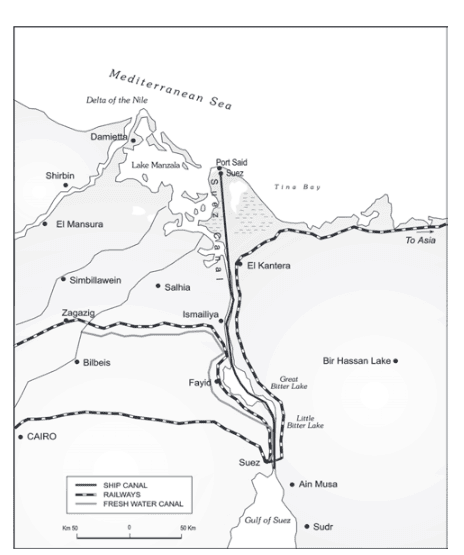 Suez Canal
Suez Canal
The Panama Canal
- Connection: Links the Atlantic Ocean (east) with the Pacific Ocean (west).
- Location: Built across the Panama Isthmus between Panama City and Colon by the U.S. government.
- Area: The U.S. purchased an 8 km area on either side, known as the Canal Zone.
- Length and Design
1. Total length: About 72 km.
2. Includes a deep cutting that is 12 km long.
3. Features a six-lock system that raises and lowers ships by 26 meters. - Distance Reduction
1. Shortens the sea distance between New York and San Francisco by 13,000 km.
2. Also reduces distances between Western Europe and the U.S. West Coast, as well as between northeastern and central U.S.A. and East and Southeast Asia. - Economic Importance: While its economic significance is less than that of the Suez Canal, it is crucial for the economies of Latin America.
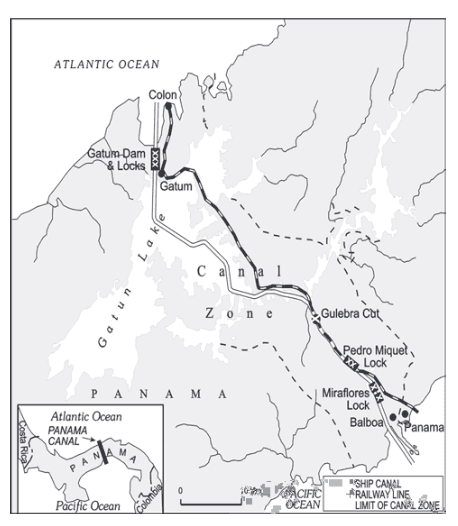 The Panama Canal
The Panama Canal
Inland Waterways
Inland waterways include rivers, canals, lakes, and coastal areas that have been used for transportation for a long time.
- Transport Methods: Boats and steamers are commonly used for moving cargo and passengers.
- Development Factors:
1. The usability of inland waterways depends on the width and depth of the channels.
2. Continuity of water flow and available transport technology also play crucial roles. - Heavy Cargo Transport:
1. Inland waterways can transport heavy goods like coal, cement, timber, and metallic ores.
2. In the past, rivers were the main transportation routes, particularly in places like India.
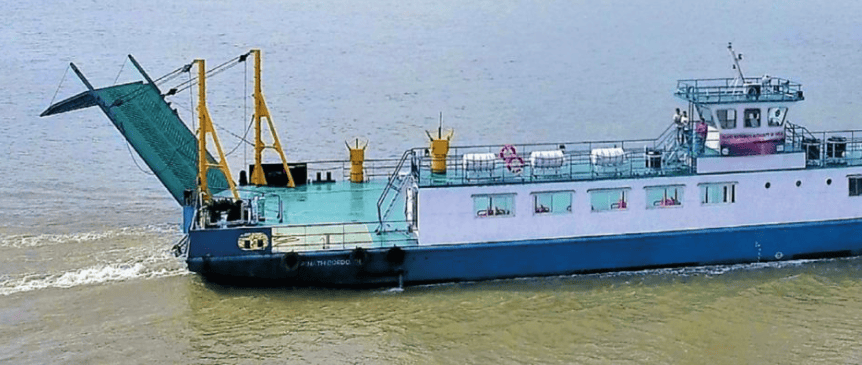 Inland waterways
Inland waterways
- Decline in Use: Inland waterways lost significance due to competition from railways, diversion of water for irrigation, and poor maintenance.
- Current Importance
1. The importance of rivers for domestic and international transport and trade is acknowledged in developed countries.
2. Many rivers have been improved for navigation through dredging, stabilizing banks, and building dams to regulate water flow. - Notable Waterways: Some of the world’s key commercial riverways are recognized as major highways for trade.
The Rhine Waterways
- Location: The Rhine River flows through Germany and the Netherlands.
- Navigable Distance: It is navigable for 700 km, from Rotterdam in the Netherlands to Basel in Switzerland.
- Ship Access: Ocean-going vessels can reach as far as Cologne.
- Key Tributary: The Ruhr River, which flows through a rich coalfield, joins the Rhine from the east, supporting a prosperous manufacturing area.
- Major Port: Düsseldorf serves as the main port for the Rhine region.
- High Traffic: The Rhine is the most heavily used waterway in the world, with over 20,000 ocean-going ships and 200,000 inland vessels exchanging cargo each year.
- Economic Importance: It connects the industrial regions of Switzerland, Germany, France, Belgium, and the Netherlands to the North Atlantic Sea Route.
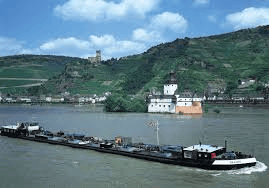 The Rhine Waterway
The Rhine Waterway
The Danube Waterway
- Location: The Danube River flows through Eastern Europe.
- Source: It rises in the Black Forest.
- Navigable Distance: The river is navigable up to Târgu Jiu (previously referred to as Taurna Severin).
- Main Exports: Important goods transported via the Danube include wheat, maize, timber, and machinery.
The Volga Waterway
- Location: The Volga River is a major waterway in Russia.
- Length: It spans 11,200 km and flows into the Caspian Sea.
- Connections
1. The Volga-Moscow Canal links the Volga to the Moscow region.
2. The Volga-Don Canal connects it to the Black Sea. - Importance: The Volga is one of the most significant waterways in Russia.
The Great Lakes – St. Lawrence Seaway
- Lakes Involved: The Great Lakes include Superior, Huron, Erie, and Ontario.
- Connection: They are linked by the Soo Canal and Welland Canal, creating an inland waterway.
- Commercial Waterway: The estuary of the St. Lawrence River combined with the Great Lakes forms a key commercial route in northern North America.
- Ports: Important ports like Duluth and Buffalo have facilities similar to ocean ports.
- Navigation: Large ocean-going ships can travel up the river to Montreal. However, due to rapids, goods must be transferred to smaller vessels.
- Canal Depth: Canals have been built to a depth of 3.5 meters to help avoid these navigation issues.
The Mississippi Waterways
- Connection: The Mississippi-Ohio waterway links the interior of the U.S.A. to the Gulf of Mexico in the south.
- Navigation: Large steamers can travel this route all the way up to Minneapolis.
Air Transport
- Speed: Air transport is the fastest way to travel, making it popular for long distances.
- Cost: Despite its speed, it is very expensive compared to other modes of transport.
- Cargo Transport: It allows for quick movement of valuable cargo globally.
- Access to Remote Areas: Air travel is often the only way to reach inaccessible regions, like remote Arctic areas or during natural disasters in mountainous regions.
- Connectivity Revolution: Air transport has greatly improved global connectivity, overcoming barriers like mountains and deserts.
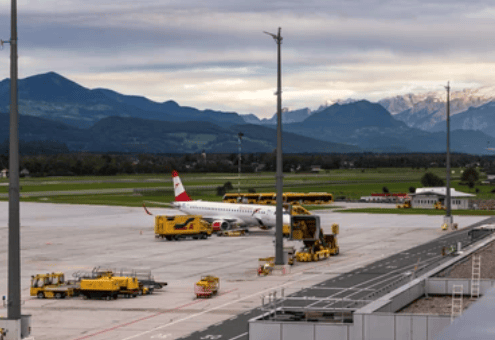 An Aeroplane at Salsburg Airport
An Aeroplane at Salsburg Airport
- Strategic Importance: Air transport plays a crucial role in military operations, as seen in conflicts like Iraq.
- Infrastructure Needs: Operating aircraft requires significant infrastructure, including airports, hangars, and maintenance facilities, which can be costly.
- Global Reach: Currently, no place in the world is more than 35 hours away by air, enabling travel in hours instead of months.
- Growth: The airways network is rapidly expanding, with over 250 commercial airlines now offering services worldwide.
- Future Innovations: Advancements like supersonic aircraft are changing the future of air travel, significantly reducing travel times.
Inter-Continental Air Routes
- East-West Belt: In the Northern Hemisphere, there is a clear east-west network of international air routes.
- Dense Networks: Major areas with a lot of air traffic include Eastern U.S.A., Western Europe, and Southeast Asia.
- U.S. Dominance: The United States alone has 60% of the world’s air routes.
- Major Cities: Important hubs where many air routes connect include New York, London, Paris, Amsterdam, Frankfurt, Rome, Moscow, Karachi, New Delhi, Mumbai, Bangkok, Singapore, Tokyo, San Francisco, Los Angeles, and Chicago.
- Lack of Services: Africa, the Asian part of Russia, and South America have few air services.
- Limited Southern Routes: In the Southern Hemisphere, there are only a few air services between latitudes 10-35° due to sparser populations, limited land area, and less economic development.
Pipelines
- Purpose: Pipelines are widely used to transport liquids and gases, such as water, petroleum, and natural gas, ensuring a steady flow.
- Common Uses
1. Water supply through pipelines is common.
2. LPG (cooking gas) is piped in many regions.
3. In New Zealand, milk is transported via pipelines from farms to factories. - U.S. Network: The U.S. has a dense network of oil pipelines connecting production areas to consumption areas. A notable example is the Big Inch pipeline, which transports oil from the Gulf of Mexico to the northeastern states. About 17% of freight is moved by pipelines in the U.S.
- Global Use: In Europe, Russia, West Asia, and India, pipelines connect oil wells to refineries and ports or local markets.
- International Projects: Turkmenistan has extended pipelines to Iran and parts of China. A proposed Iran-India pipeline through Pakistan would be the longest in the world.
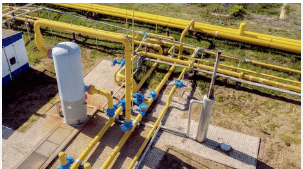 Pipelines transporting natural gas in Ukraine
Pipelines transporting natural gas in Ukraine
Communications
- Early Methods: Humans have used various methods for long-distance communication, with the telegraph and telephone being significant.
- Telegraph's Role: The telegraph played a crucial role in the colonization of the American West.
- AT&T Monopoly: In the early to mid-20th century, the American Telegraph and Telephone Company (AT&T) dominated the U.S. telephone market.
- Urbanization Impact: The telephone was vital for the urbanization of America, as businesses centralized operations in cities and opened branch offices in smaller towns.
- Current Use: The telephone remains the most widely used communication tool. In developing countries, cell phones have become essential for connecting rural areas, thanks to satellite technology.
- Rapid Development: There has been a significant pace of development in telecommunications.
- Optic Fiber Cables: The introduction of optic fiber cables (OFC) was a major breakthrough.
- Upgrade from Copper: To compete effectively, telephone companies upgraded from copper cables to optic fiber cables, which can transmit large amounts of data quickly and securely with minimal errors.
- Digitization and the Internet: With the rise of digitization in the 1990s, telecommunications began to merge with computers, creating integrated networks known as the Internet.
Satellite Communication
- Global Internet Network: The Internet is the largest electronic network in the world, connecting about 1 billion people across more than 100 countries.
- Satellite Communication Development: Satellite communication became a significant area in communication technology starting in the 1970s, thanks to space research by the U.S.A. and the former U.S.S.R.
- Artificial Satellites: Artificial satellites are now successfully placed in Earth's orbit, allowing communication even in remote areas with minimal verification needed.
- Cost and Distance: The cost and time for communication via satellite remain the same regardless of distance, meaning it costs just as much to communicate over 500 km as it does over 5,000 km.
- India’s Satellite Progress: India has made significant advances in satellite technology:
1. Aryabhatt was launched on April 19, 1979.
2. Bhaskar-I and Rohini were launched in 1979 and 1980, respectively.
3. APPLE was launched on June 18, 1981. - Impact on Communication: Satellites like Bhaskar, Challenger, and INSAT I-B have greatly improved long-distance communication, television, and radio services.
- Weather Forecasting: Satellite technology has made weather forecasting through television very effective, benefiting society significantly.

Cyber Space – Internet
Cyberspace is the digital world created by electronic computers and the Internet, including the World Wide Web (www).
- It serves as a virtual space for communicating and accessing information without needing to be in the same physical location as others.
- Essentially, it's the Internet, which can be found anywhere—be it in an office, on a boat, or in a plane.
- The speed of growth in this electronic network is unmatched in history.
1. In 1995, there were fewer than 50 million Internet users.
2. By 2000, this number grew to about 400 million.
3. In 2010, there were over two billion users. - Recently, the majority of Internet users have shifted from the U.S.A. to developing countries. The U.S. share of users dropped from 66% in 1995 to 25% in 2005.
- Major users now include countries like the U.S.A., U.K., Germany, Japan, China, and India.
- As billions continue to use the Internet, cyberspace will enhance economic and social activities through:
1. E-mail
2. E-commerce
3. E-learning
4. E-governance - Modern communication tools like the Internet, along with fax, TV, and radio, are increasingly accessible, bridging distances and making the concept of a global village a reality.
|
50 videos|273 docs|37 tests
|
FAQs on Transport and Communication Class 12 Geography
| 1. What are the main modes of transportation? |  |
| 2. How does land transport impact the environment? |  |
| 3. What are the advantages of using water transport? |  |
| 4. What role do pipelines play in transportation? |  |
| 5. How has air transport evolved over the years? |  |





















